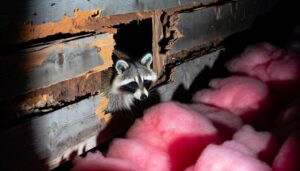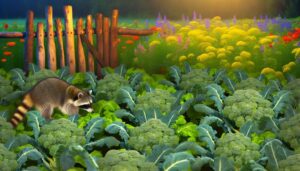Do Raccoons Live in California: Identifying Their Habitats
Yes, raccoons are extensively distributed across California. They adapt to a variety of habitats, including urban landscapes, coastal forests, and mountainous regions.
Raccoons are nocturnal, utilizing human infrastructure for shelter and foraging. In rural settings, they feed on fruits, nuts, and small aquatic organisms, while in urban areas, they often scavenge through garbage.
Their activity levels fluctuate seasonally, with increased nocturnal behavior in summer and reduced foraging in winter. Raccoons play an essential ecological role in pest control and seed dispersal, but can also cause property damage and transmit diseases.
Learn about their behavior and habitat preferences.

Key Takeaways
- Raccoons inhabit urban landscapes, coastal forests, and mountainous regions in California.
- They exploit human infrastructure for shelter and scavenging opportunities.
- Raccoons are adaptable, thriving in areas with abundant water, food, and cover.
- They forage for fruits, nuts, and small aquatic organisms in both urban and rural settings.
- Seasonal activity changes include increased nocturnal foraging during summer and energy conservation in winter.
Raccoon Habitats in California

Raccoon habitats in California are diverse, ranging from urban landscapes to coastal forests and mountainous regions, reflecting the species' adaptability to various environments.
In urban areas, raccoons exploit human infrastructure, utilizing sewers, attics, and parks for shelter and scavenging.
Coastal forests provide rich ecosystems where raccoons forage for fruits, nuts, and small aquatic organisms.
Mountainous regions offer a mix of dense vegetation and water sources, ideal for denning and foraging.
Raccoons are highly adaptable, thriving in areas with abundant water, food, and cover. This versatility enables them to inhabit a wide array of habitats, from the arid regions of Southern California to the temperate rainforests of the northern coast, underscoring their ecological plasticity.
Raccoon Behavior Patterns
Exhibiting nocturnal tendencies, raccoons demonstrate complex behavior patterns characterized by their resourcefulness, problem-solving abilities, and social interactions. These mammals are adept at manipulating their environment to access food and shelter, often employing their dexterous front paws to achieve their goals. Their behavior is marked by an innate curiosity and a high level of intelligence, enabling them to adapt to diverse habitats.
Foraging Behavior: Raccoons employ a variety of techniques to locate and extract food.
Social Structure: While generally solitary, raccoons may form loose groups, especially females with young.
Communication: They utilize a range of vocalizations, body language, and scent marking.
Territoriality: Raccoons establish and defend territories, particularly during breeding season.
Seasonal Patterns: Their activity levels can vary with the season, showing increased foraging in autumn.
Urban and Rural Interactions

Given their complex behavioral patterns and adaptability, these intelligent mammals frequently navigate both urban and rural environments, highlighting the diverse interactions they have with human communities and natural landscapes.
In urban settings, raccoons often exploit resources such as garbage, pet food, and garden crops, demonstrating remarkable problem-solving abilities.
Conversely, in rural areas, they primarily forage for natural food sources like fruits, insects, and small vertebrates.
Their presence in both settings can lead to conflicts, particularly when they damage property or transmit diseases such as rabies and leptospirosis.
Nevertheless, raccoons play a pivotal ecological role by controlling pest populations and contributing to seed dispersal, thereby maintaining the balance within California's varied ecosystems.
Seasonal Activity Changes
Throughout the year, raccoons in California exhibit notable variations in their activity patterns, driven largely by seasonal changes in temperature, food availability, and reproductive cycles. During the warmer months, raccoons are more nocturnal, foraging for a diverse diet of fruits, insects, and small animals.
In contrast, colder periods see a reduction in activity as food becomes scarce and energy conservation becomes critical. Breeding season, typically from January to March, further influences their activity, with increased movements associated with mating behaviors.
Increased nocturnal activity during summer
Reduced foraging during winter months
Peak breeding activities in early spring
Dietary shifts based on seasonal food availability
Energy conservation strategies in colder weather
These seasonal adaptations illustrate the raccoon's ability to thrive in California's varied climate.
Managing Raccoon Encounters

Effectively managing raccoon encounters in California requires a thorough understanding of their behavior, habitat preferences, and the potential risks they pose to humans and property. Raccoons are nocturnal and highly adaptable, often residing in urban and suburban areas. They are known to forage through garbage and can carry diseases such as rabies. Implementing preventive measures, such as securing trash cans and eliminating food sources, is essential. Additionally, understanding their nesting habits can help reduce property damage.
| Factor | Description | Management Strategy |
|---|---|---|
| Behavior | Nocturnal, foraging | Secure trash cans |
| Habitat | Urban, suburban areas | Eliminate food sources |
| Risks | Disease transmission, property damage | Rabies vaccination, secure nesting areas |
| Prevention | Public education, deterrents | Community awareness programs |
| Intervention | Trapping, relocation | Professional wildlife services |
Proper management guarantees coexistence while minimizing negative interactions.
Conclusion
To sum up, raccoons thrive in varied habitats across California, displaying distinct behavior patterns that aid their survival in both urban and rural settings. Seasonal activity changes impact their interactions with human populations, requiring thorough management strategies.
How can understanding these patterns and behaviors improve coexistence with this adaptable species? By conducting scientific analysis and strategic planning, successful management of raccoon encounters can be accomplished, guaranteeing minimal disruption to both the environment and human communities.






